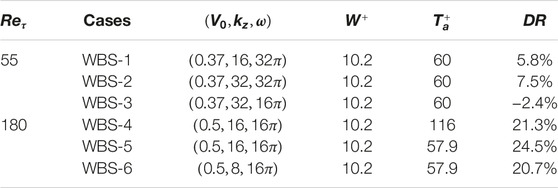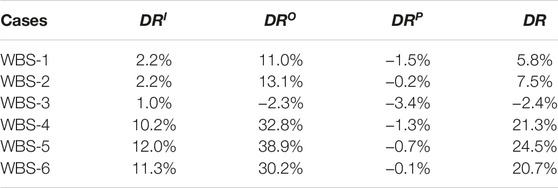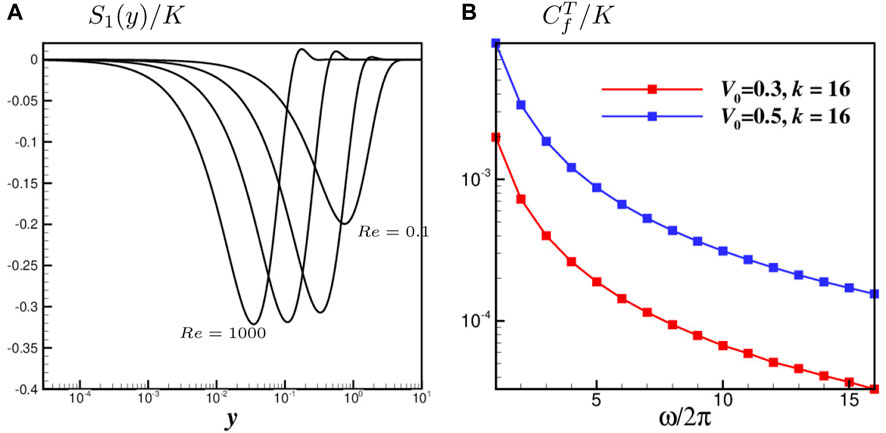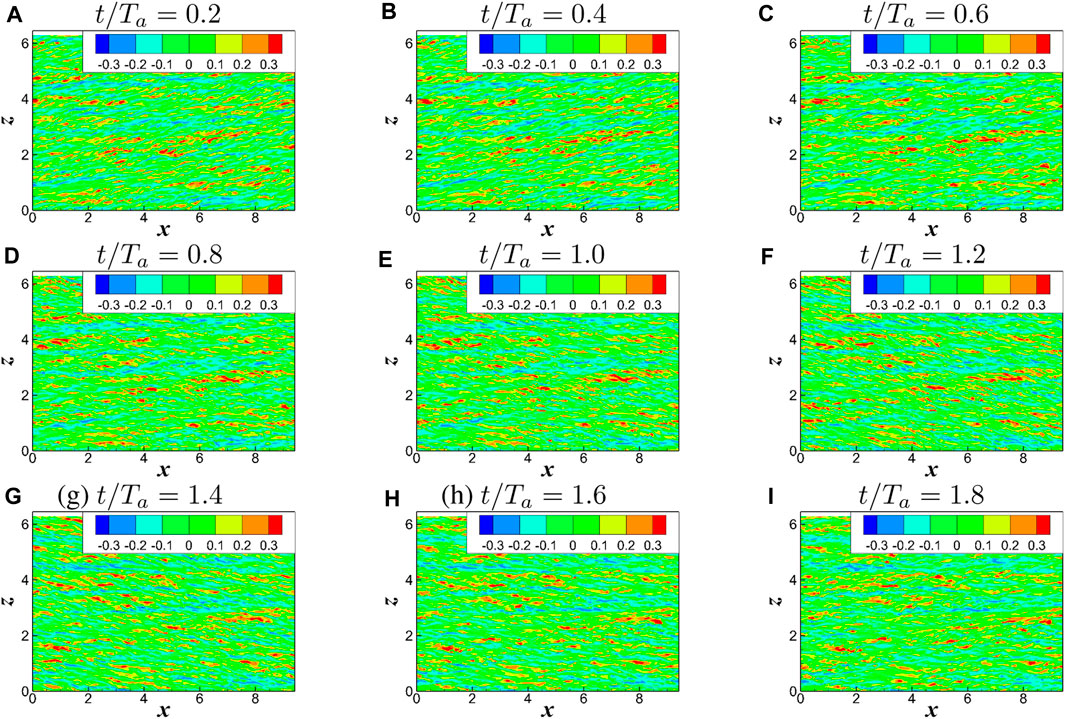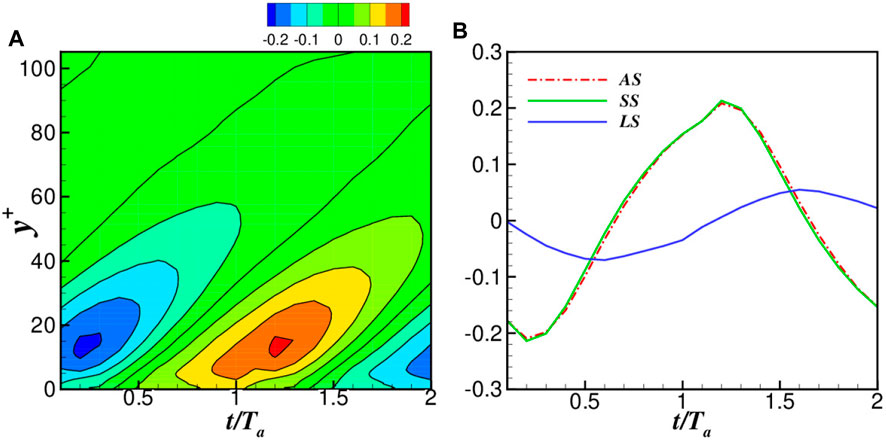- School of Aerospace Engineering, Tsinghua University, Beijing, China
Turbulent channel flows with Reτ = 180 and Reτ = 550 are controlled to reduce the drag with a spanwise traveling wave of the blowing and suction method. An oscillatory spanwise motion is generated with a periodically reversing propagation direction of the traveling wave, similarly as the wall oscillation. Direct numerical simulation (DNS) results show that this kind of blowing and suction control can achieve a drag reduction rate of 24.5% with Reτ = 180, and 7.5% with Reτ = 550. The reasons for the deterioration in drag reduction rates are thought to be the lift-up mechanism by the actuation through an asymptotic expansion method, and the controlled inner regions and small-scale structures having less significance when the Reynolds number is high.
Introduction
Nearly 55% of total drag is a viscous drag for a civil aircraft [1]. A 0.75% reduction in fuel consumption can be achieved with a 1% reduction in skin friction [2]. Thus, it has been an important goal to reduce the viscous drag in the area of flow control in turbulent boundary layer flows. There are two conventional routes for flow control near the wall, passive control and active control. For the former extra energy input is not needed and a drag reduction of about 10% can be achieved. The most popular passive control strategy is building streamwise riblets at the wall, which can reduce the viscous drag by about 7%–10%, with a restriction on the spanwise crossflow in the near wall region. However, the requirements of an effective riblet shape are strict [3–5]. In active control strategies, energy outside the flow was imposed and the turbulent skin friction is reduced more effectively compared with the passive control. The wall oscillation (noted as WOS hereinafter) was thought to be a simple and effective way to reduce the drag to an extent of about 40% with a total energy saving of 7%. [6–10] The flow generated by WOS,
Plenty of studies have tried to figure out how the Stokes layer reduces the drag and weakens the near-wall turbulence after Jung et al. first performed the numerical experiment of WOS control in a turbulent channel flow [6].
Since the spanwise velocity becomes non-negligible in the transport equations of Reynolds stresses after control, some studies analyzed the differences in the energy budget of turbulence. A reduced pressure-strain correlation term is believed to be closely related to the suppression of the wall-normal stress, which led to a reduction in the level of shear stress and streamwise stress. Hence, the near-wall turbulence is weakened, leading to a reduction of skin friction at the wall [12–15]. Also, the pressure-strain terms play a significant role during the transient response after control [16]. However, the mechanism of the Stokes layer suppressing the pressure-strain correlation is still unclear. The quasi-streamwise vortex and streaks are significant structures in the self-sustaining cycle of near-wall turbulence, and were found to be inclined periodically with the wall motion [17–19]. Some models based on linearized Navier–Stokes equations were proposed to described the relation between the Stokes layer and the inclination [17, 20]. It is also thought that the inclined streaks and vortex weaken the generation of turbulence, and thus led to a reduction in the drag [14, 15, 21]. The Reynolds number dependence of the WOS control is of vital significance, since the Reynolds number around a real aircraft,
The Stokes layer is simple and proven effective in reducing drag by many experimental and numerical results, but the periodic wall motion might not be easily attainable in practical applications. Using other methods to generate an oscillatory spanwise motion to mimic the Stokes layer has also gained much research interest. A streamwise traveling wave of wall motion [27–30], rotating discs [31–33], wavy riblets [27], spanwise forcing [34–36], and spanwise jet [37] have been investigated and found effective in reducing drag. A spanwise traveling wave of the blowing and suction method is studied in the present work to reduce skin friction in a fully developed turbulent channel flow. Different from a streamwise traveling wave [38–40], which can reduce the drag even to a laminar level by increasing the flow rate, the spanwise traveling wave investigated here has a periodically reversing propagation direction, noted as WBS. The Reynolds number dependence of the drag reduction and its mechanism are mainly discussed in this study.
This manuscript is arranged as follows. Control Strategy section introduces the motion induced by the spanwise traveling wave and the uncontrolled base-flow. Results and Discussion section shows the performances of this control strategy and analyze the mechanism in the channel flows with
Control Strategy
The Motion Induced by the Traveling Wave
Min et al. found that an upstream traveling wave of blowing and suction can achieve a sustained sub-laminar drag in a turbulent channel flow [38]. However, some studies have proved that this kind of traveling wave can generate a flux opposed to the wave propagation direction [40], and it is more like a pumping than drag reduction effect [39]. Inspired by the streamwise traveling wave, we make the wave reverse in the spanwise direction periodically to mimic the oscillatory wall motion in WOS, shown in Eq. 2.
where
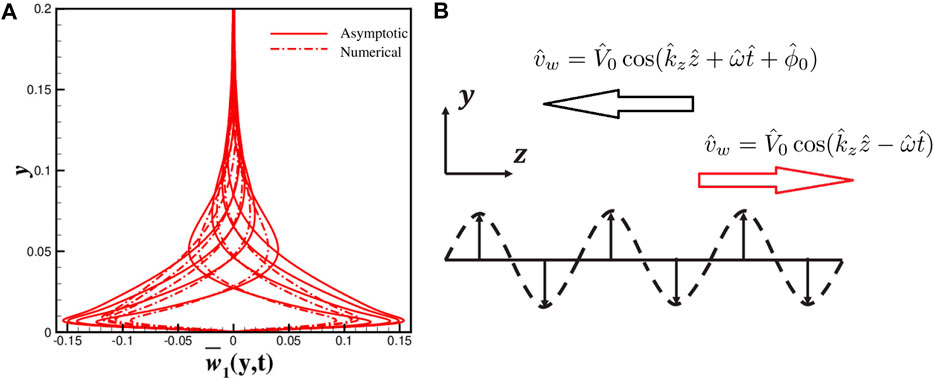
FIGURE 1. (A) Spanwise velocity
To resolve the WBS induced flow in a quiescent background, an asymptotic expansion method is applied as shown in Eq. 4a–c:
where
where
The zero-order terms are a traveling wave in the same direction as actuation, which is also called the harmonic part in the manuscript. The harmonic part decays as the distance to the wall y increases, and the protrusion height is defined as
The average of the first order terms is of much significance in this study:
And it can be solved with known zero order terms (Eq. 5a, b):
where the constant
In summary, the motion induced by the spanwise traveling wave can be approximately decomposed into a harmonic part (Eq. 5a, b) and a Stokes part (Eqs 8a-e) with the asymptotic solution.
The Numerical Method and Base Flow
Incompressible fully developed turbulent channel flows with
High order methods based on CPR(correction procedure via reconstruction) [43] are used here and seventh order polynomials are used for space discretization. For the viscous term, it is discretized with BR2 (the second approach of Bassi and Rebay) [44] and interior penalty method. The time advancement strategy is a third order explicity Euler scheme with a time step
The length and velocity scales are normalized by
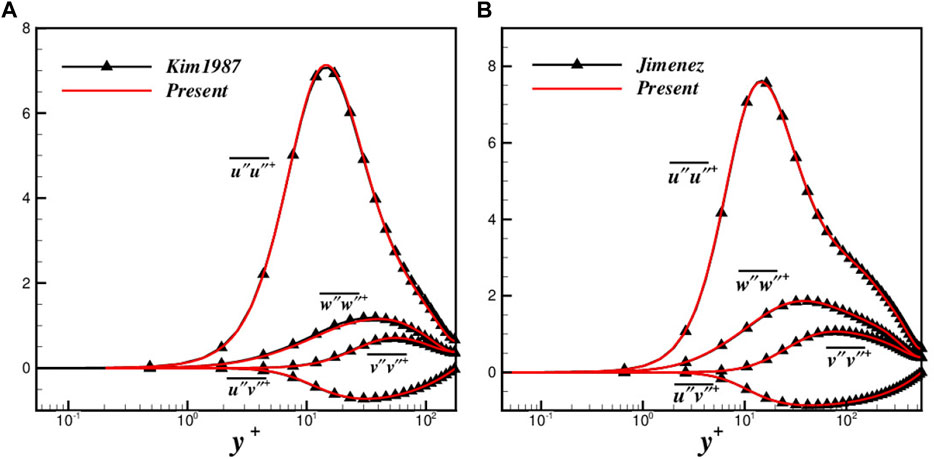
FIGURE 2. Comparison of Reynolds stress (A) between the present study and Kim et al. [45] with
Results and Discussion
The spanwise traveling wave of blowing and suction control is imposed only at the bottom wall (
where
FIK Identity Analysis
The variables in WBS control are decomposed into three parts:
where
where
The turbulent skin friction part can be further decomposed into two parts [23, 24], one from the inner region (
Therefore the drag reduction rate can be decomposed as shown in Eqs 13a-d:
where
The effects of
Since it is uniform in streamwise direction, there is no
It is obvious that
In addition, the skin friction from the periodic part,
As shown in Figure 4, the
As discussed in Control Strategy section, the induced flow by the traveling wave of blowing and suction with a periodically reversed wave speed can be decomposed into two parts, one is the harmonic part (zero order terms) and the other is the Stokes part (first order terms). The harmonic part will induce a negative shear stress, as shown in Eq. 16c, and lead to a positive contribution the skin friction through
Scale Separation Analysis
In this section, a Fourier expansion based on spanwise direction is imposed to the fluctuation field variables,
where the superscript “*” represents the complex conjugate. As a result, the skin friction coefficient from the turbulent shear stress,
Thus, the contribution from the scale
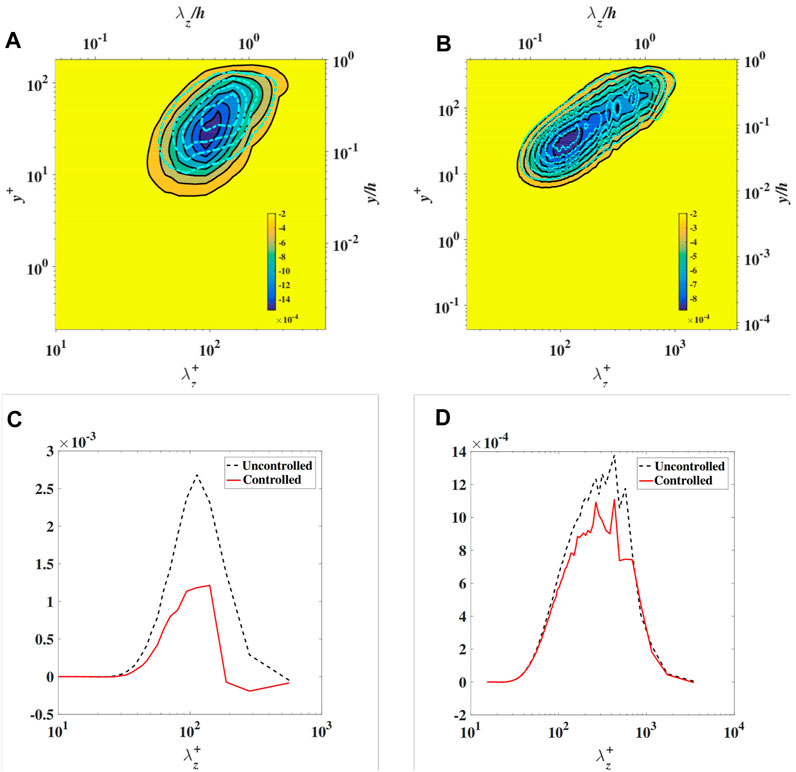
FIGURE 5. The pre-multiplied shear stress
It was found that the vortex structures are inclined by the Stokes layers in WOS, which has a close relation to the drag reduction mechanism [14, 15, 17–19]. In our previous analysis based on the
The contours of the streaks and
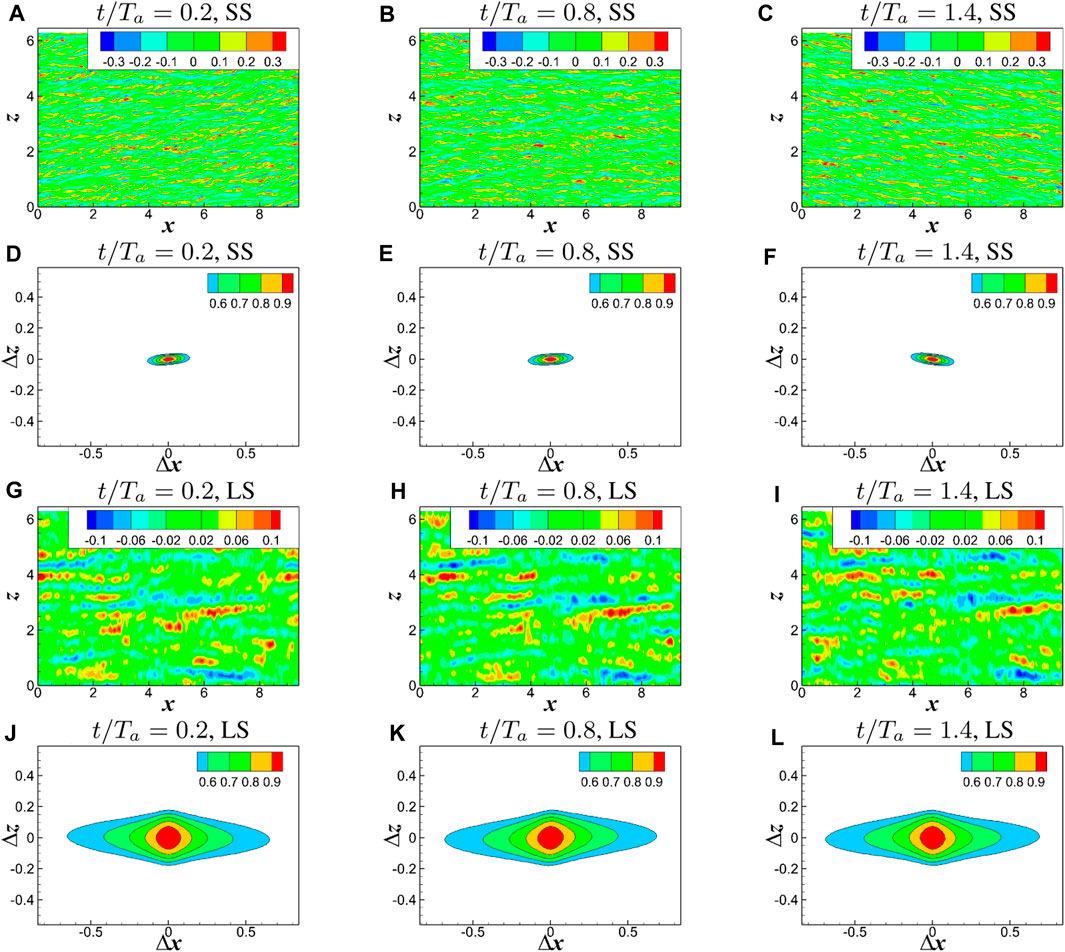
FIGURE 7. The streaks at
In physical space, the oscillatory spanwise motion or the Stokes part mainly weakens the inner region (
Conclusion
In this study, the drag reduction performance of the spanwise traveling wave of blow and suction with a periodically reversing propagation direction in
The drag reduction rates are much smaller in
Data Availability Statement
The original contributions presented in the study are included in the article/supplementary material, further inquiries can be directed to the corresponding author.
Author Contributions
All authors listed have made a substantial, direct, and intellectual contribution to the work and approved it for publication.
Funding
China-EU Program: Drag Reduction via Turbulent Boundary Layer Flow Control (DRAGY), Grant agreement ID: 690623.
Conflict of Interest
The authors declare that the research was conducted in the absence of any commercial or financial relationships that could be construed as a potential conflict of interest.
References
1. Schrauf, G. Status and Perspectives of Laminar Flow. Aeronaut J (2005) 109(1102):639–44. doi:10.1017/s000192400000097x
2. Ricco, P, and Lesshziner, MA. A Review of Turbulent Skin Friction Drag Reduction by Near Wall Transverse Forcing (2021). arXiv:2013.04719v1.
3. Choi, H, Moin, P, and Moser, R. Direct Numerical Simulation of Turbulent Flow Over Riblets. J Fluid Mech (1993) 255:503–39. doi:10.1017/s0022112093002575
4. Luchini, P, Manzo, F, and Pozzi, A. Resistance of a Grooved Surface to Parallel Flow and Cross-Flow. J Fluid Mech (1991) 228(228):87–109. doi:10.1017/s0022112091002641
5. Bechert, DW, Bruse, M, Hage, JGT, Van Der Hoeven, W, and Hoppe, G. Experiments on Drag-Reducing Surfaces and Their Optimization With an Adjustable Geometry. J Fluid Mech (1997) 338:59–87. doi:10.1017/s0022112096004673
6. Jung, WJ, Mangiavacchi, N, and Akhavan, R. Suppression of Turbulence in Wall-Bounded Flows by High-Frequency Spanwise Oscillations. Phys Fluids A: Fluid Dyn (1992) 4(8):1605–7. doi:10.1063/1.858381
7. Quadrio, M, and Ricco, P. Initial Response of a Turbulent Channel Flow to Spanwise Oscillation of the Walls. J Turbulence (2003) 4(7):1–23. doi:10.1088/1468-5248/4/1/007
8. Ricco, P, and Quadrio, M. Wall-Oscillation Conditions for Drag Reduction in Turbulent Channel Flow. Int J Heat Fluid Flow (2008) 29:891–902. doi:10.1016/j.ijheatfluidflow.2007.12.005
9. Quadrio, M, and Ricco, P. Critical Assessment of Turbulent Drag Reduction Through Spanwise Wall Oscillations. J Fluid Mech (2004) 521:251–71. doi:10.1017/s0022112004001855
10. Quadrio, M, Ricco, P, and Claudio, V. Streamwise-Traveling Waves of Spanwise Wall Velocity for Turbulent Drag Reduction. J Fluid Mech (2009) 627:161–78.
12. Touber, E, and Leschziner, MA. Near-Wall Streak Modification by Spanwise Oscillatory Wall Motion and Drag-Reduction Mechanisms. J Fluid Mech (2012) 693(2):150–200. doi:10.1017/jfm.2011.507
13. Ricco, P, Ottonelli, C, Hasegawa, Y, and Quadrio, M. Changes in Turbulent Dissipation in a Channel Flow With Oscillating Walls (2012). arXiv preprint arXiv:1202.3534.
14. Agostini, L, Touber, E, and Leschziner, M. The Turbulence Vorticity as a Window to the Physics of Friction Drag Reduction by Oscillatory Wall Motion. Int J Heat Fluid Flow (2015) 51(3–15):3–15. doi:10.1016/j.ijheatfluidflow.2014.08.002
15. Huang, Y, Wang, L, and Fu, S. Drag Reduction in Turbulent Channel Flows by a Spanwise Traveling Wave of Wall Blowing and Suction. Phys Fluids (2021) 33:095111. doi:10.1063/5.0061279
16. Xu, C-X, and Huang, W-X. Transient Response of Reynolds Stress Transport to Spanwise Wall Oscillation in a Turbulent Channel Flow. Phys Fluids (2005) 17(1):018101. doi:10.1063/1.1827274
17. Blesbois, O, Chernyshenko, SI, Touber, E, and Leschziner, MA. Pattern Prediction by Linear Analysis of Turbulent Flow With Drag Reduction by Wall Oscillation. J Fluid Mech (2013) 724:607–41. doi:10.1017/jfm.2013.165
18. Choi, K-S. Near-Wall Structure of Turbulent Boundary Layer With Spanwise-Wall Oscillation. Phys Fluids (2002) 14(7):2530–42. doi:10.1063/1.1477922
19. Chernyshenko, SI, and Baig, MF. The Mechanism of Streak Formation in Near-Wall Turbulence. J Fluid Mech (2005) 544:99–113. doi:10.1017/s0022112005006506
20. Moarref, R, and Jovanovic, MR. Model-Based Design of Transverse Wall Oscillations for Turbulent Drag Reduction. J Fluid Mech (2012) 707:205–40. doi:10.1017/jfm.2012.272
21. Yakeno, A, Hasegawa, Y, and Kasagi, N. Modification of Quasi-Streamwise Vortical Structure in a Drag-Reduced Turbulent Channel Flow With Spanwise Wall Oscillation. Phys Fluids (2014) 26(8):085109. doi:10.1063/1.4893903
22. Gatti, D, and Quadrio, M. Performance Losses of Drag-Reducing Spanwise Forcing at Moderate Values of the Reynolds Number. Phys Fluids (2013) 25:125109. doi:10.1063/1.4849537
23. Hurst, E, Yang, Q, and Chung, YM. The Effect of Reynolds Number on Turbulent Drag Reduction by Streamwise Travelling Waves. J Fluid Mech (2014) 759:28–55. doi:10.1017/jfm.2014.524
24. Yao, J, Chen, X, and Hussain, F. Reynolds Number Effect on Drag Control via Spanwise Wall Oscillation in Turbulent Channel Flows. Phys Fluids (2019) 31:085108. doi:10.1063/1.5111651
25. Agostini, L, and Leschziner, M. The Impact of Footprints of Large-Scale Outer Structures on the Near-Wall Layer in the Presence of Drag-Reducing Spanwise Wall Motion. Flow, Turbulence and Combustion (2018) 100:1037–61. doi:10.1007/s10494-018-9917-3
26. Leschziner, MA. Friction-Drag Reduction by Transverse Wall Motion-A Review. J Mech (2020) 36:649–63.
27. Ghebali, S, Chernyshenko, SI, and Leschziner, MA. Turbulent Skin-Friction Reduction by Wavy Surfaces (2017). arXiv preprint arXiv:1705.01989.
28. Skote, M. Turbulent Boundary Layer Flow Subject to Streamwise Oscillation of Spanwise Wall-Velocity. Phys Fluids (2011) 23(8):081703. doi:10.1063/1.3626028
29. Skote, M. Temporal and Spatial Transients in Turbulent Boundary Layer Flow Over an Oscillating Wall. Int J Heat Fluid Flow (2012) 38(1–12):1–12. doi:10.1016/j.ijheatfluidflow.2012.08.004
30. Skote, M. Comparison Between Spatial and Temporal Wall Oscillations in Turbulent Boundary Layer Flows. J Fluid Mech (2013) 730:273–94. doi:10.1017/jfm.2013.344
31. Wise, DJ, and Ricco, P. Turbulent Drag Reduction Through Oscillating Discs. J Fluid Mech (2014) 746(10):536–64. doi:10.1017/jfm.2014.122
32. Wise, DJ, Alvarenga, C, and Ricco, P. Spinning Out of Control: Wall Turbulence Over Rotating Discs. Phys Fluids (2014) 26:125107. doi:10.1063/1.4903973
33. Wise, DJ, Paolo, O, and Ricco, P. Turbulent Drag Reduction Through Oscillating Discs-Corrigendum. J Fluid Mech (2018) 856:1064–6.
34. Jukes, T, Choi, K-S, Johnson, G, and Scott, S. Turbulent Drag Reduction by Surface Plasma Through Spanwise Flow Oscillation (2006).
35. Jukes, T. Turbulent Drag Reduction Using Surface Plasma. PhD thesis. Nottingham: University of Nottingham (2007).
36. Wilkinson, S. Oscillating Plasma for Turbulent Boundary Layer Drag Reduction. Int J Heat Fluid Flow (2012) 38(1–12).
37. Xie, F, Pérez-Muñoz, JD, Ning, Q, and Pierre, R. Drag Reduction in Wall-Bounded Turbulence by Synthetic Jet Sheets. J Fluid Mech (2022) 941:A63. doi:10.1017/jfm.2022.347
38. Min, T, Kang, SM, Speryer, JL, and Kim, J. Sustained Sub-Laminar Drag in a Fully Developed Channel Flow. J Fluid Mech (2006) 558:309. doi:10.1017/s0022112006000206
39. Hœffner, J, and Fukagata, K. Pumping or Drag Reducion. J Fluid Mech (2009) 635:171–87. doi:10.1017/s0022112009007629
40. Woodcock, JD, Sader, JE, and Marusic, I. Induced Flow Due to Blowing and Suction Flow Control: An Analysis of Transpiration. J Fluid Mech (2011) 690:366–98. doi:10.1017/jfm.2011.441
41. Mathis, R, Hutchins, N, and Marusic, I. Large-Scale Amplitude Modulation of the Small-Scale Structures in Turbulent Boundary Layers. J Fluid Mech (2009) 628:311–37. doi:10.1017/s0022112009006946
42. Mathis, R, Monty, JP, Hutchins, N, and Marusic, I. Comparison of Large-Scale Amplitude Modulation in Turbulent Boundary Layers, Pipes, and Channel Flows. Phys Fluids (2009) 21(11). doi:10.1063/1.3267726
44. Bassi, F, and Rebay, S. Discontinuous Galerkin Solution of the Reynolds Averaged Navier-Stokes and K ω Turbulence Model Equations. J Comput Phys (2005) 34:507–40. doi:10.1016/j.compfluid.2003.08.004
45. Kim, J, Moin, P, and Moser, R. Turbulence Statistics in Fully Developed Channel Flow at Low Reynolds Number. J Fluid Mech (1987) 177:133–66. doi:10.1017/s0022112087000892
47. Gatti, D, and Quadrio, M. Reynolds-Number Dependence of Turbulent Skin-Friction Drag Reduction Induced by Spanwise Forcing. J Fluid Mech (2016) 802:553–82. doi:10.1017/jfm.2016.485
Keywords: drag reduction, turbulent channel flows, spanwise traveling wave, blowing and suction, Reynolds number dependence
Citation: Huang Y and Fu S (2024) Reynolds Number Effects on the Drag Reduction With a Spanwise Traveling Wave of Blowing and Suction in Turbulent Channel Flows. Aerosp. Res. Commun. 1:12272. doi: 10.3389/arc.2023.12272
Received: 22 October 2023; Accepted: 24 November 2023;
Published: 09 January 2024.
Copyright © 2024 Huang and Fu. This is an open-access article distributed under the terms of the Creative Commons Attribution License (CC BY). The use, distribution or reproduction in other forums is permitted, provided the original author(s) and the copyright owner(s) are credited and that the original publication in this journal is cited, in accordance with accepted academic practice. No use, distribution or reproduction is permitted which does not comply with these terms.
*Correspondence: Song Fu, ZnMtZGVtQHRzaW5naHVhLmVkdS5jbg==
 Yi Huang
Yi Huang Song Fu
Song Fu
